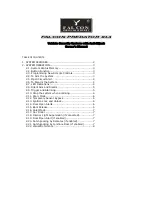
11
4.3 Receivers connecting
Receivers are connected to the zones of c.i.e. only one at a time and transmit
the status of "ALARM (FIRE)" by increasing current consumption and closing the
“ALARM” contacts. Connection to the alarm loops is shown in Figure 3.
"ZONE"
"ALARM"
"FAULT"
"ZONE"
"FAULT"
"FAULT"
"FAULT"
"ALARM"
zone n
c. i. e.
receiver 1
zone n+1
zone 1
receiver n
Figure 3
The total resistance of the wires should not exceed 250/n ohms.
The output "ALARM (FIRE)" is galvanically isolated (dry contact). In the
quiescent mode (as well as "FAULT" and "FAULT-TEST") contacts are open, in the
“ALARM (FIRE)”, “ALARM-TEST” modes contacts are closed.
When using the "ALARM" outputs, each of them is connected to one alarm
loop in accordance with the description for the device used.
Alternative option is to connect the outputs "ALARM" of all receivers to one
zone with current-limiting resistors RLIM at the every receiver and terminating
resistor RT on the farthest receiver (Figure 4). In this case, the alarms on all the
connected receivers will be processed by OR, that is, if it is alarm at least in one





































